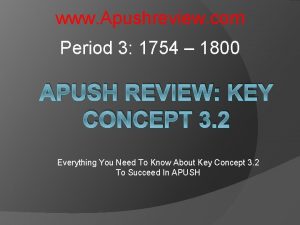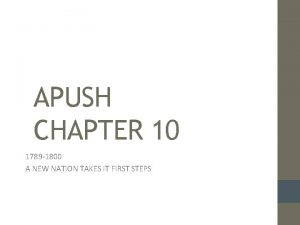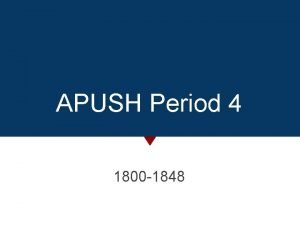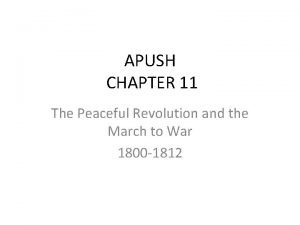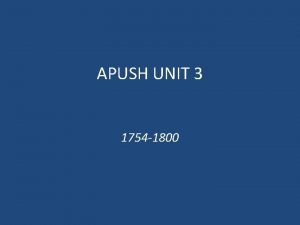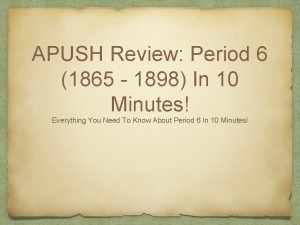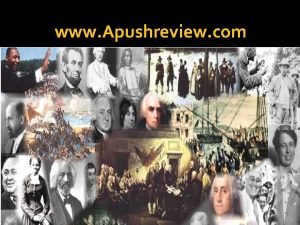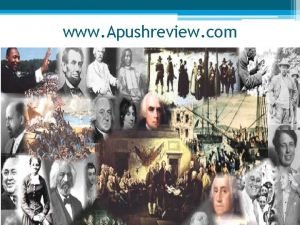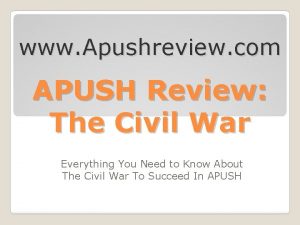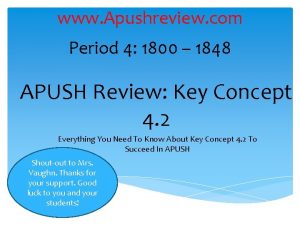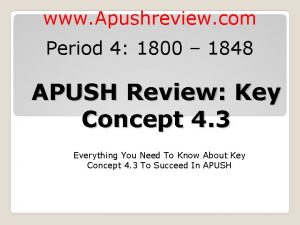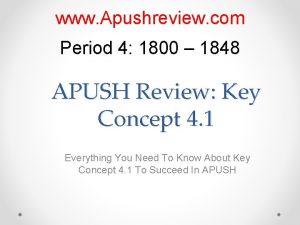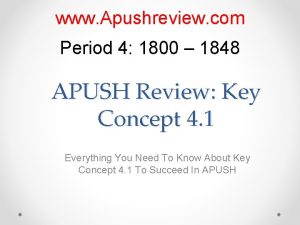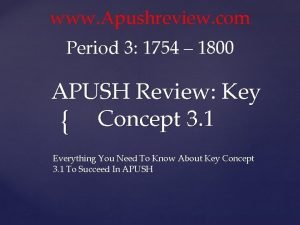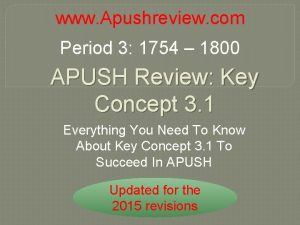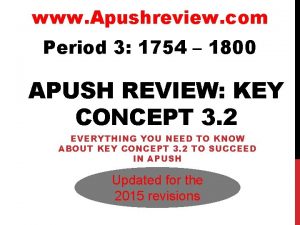www Apushreview com Period 4 1800 1848 APUSH










- Slides: 10

www. Apushreview. com Period 4: 1800 – 1848 APUSH Review: Key Concept 4. 1 Everything You Need To Know About Key Concept 4. 1 To Succeed In APUSH Updated for the 2015 revisions

The New Curriculum • Key Concept 4. 1 “The United States began to develop a modern democracy and celebrated a new national culture, while Americans sought to define the nation’s democratic ideals and change their society and institutions to match them. ” o Page 44 of the Curriculum Framework • Big ideas: o What were the reasons for the development of political parties, and characteristics of each party? o How did the Second Great Awakening impact America? o How did slaves adapt to their circumstances and create a new culture?

Key Concept 4. 1 I • “The nation’s transition to a more participatory democracy was achieved by expanding suffrage from a system based on property ownership to one based on voting by all adult white men, and it was accompanied by the growth of political parties. ” – page 44 of the curriculum framework • A. Political Parties in the early 1800 s (Federalists and Jeffersonians) o Federalists: favored stronger central government, supported by upper-class, merchants and bankers, and Pro-British, loose interpretation of the Constitution o Democratic-Republicans: states-rights, supporter by lower and middle classes, farmers, Pro -French, strict interpretation of the Constitution • Both parties developed out of Hamilton’s Financial Plan and the French Revolution • B. The Supreme Court strengthened the power of the federal government, often at the expense of state governments: o Marbury v. Madison – established the principle of judicial review o Mc. Culloch v. Maryland – upheld constitutionality of 2 nd BUS, federal government given more power of states o Gibbons v. Ogden – Congress, NOT states can control interstate commerce

Key Concept 4. 1 I • C. Democrats and Whigs o Democrats: Led by Andrew Jackson, the “Common Man”: against BUS and the American System o Whigs: (Henry Clay!) Anti-Andrew Jackson; favored stronger federal government, internal improvements, tariffs, and the BUS • D. Regional political and economic loyalties overshadowed national concerns: • • • Nullification Crisis (1833)– South Carolina and other southern states opposed the Tariffs of 1828 and 1832; South Carolina even nullified those tariffs South Carolina threatened to secede if Jackson collected the tariff by force Webster’s 2 nd Reply to Hayne – Webster promoted nationalism over sectionalism

Key Concept 4. 1 II • “While Americans embraced a new national culture, various groups developed distinctive cultures of their own. ” – page 45 of the curriculum framework • A. The 2 nd Great Awakening sought to inspire humans to achieve perfection: o Charles G. Finney – massive sermons to convert individuals o Utopian Societies – social experiments that hoped to achieve perfection in communities – Oneidas, Brooke Farm, etc. o Inspired other reform movements: • Temperance, Abolitionism • B. The emergence of a new national culture o Was a combination of European and local culture o New American Art, literature, and architectural ideas emerged • Examples: John James Audubon – made significant contributions to the study of birds – prints of birds • The Hudson River School – focused on landscape paintings; believed nature was a great source of wisdom and inspiration

Key Concept 4. 1 II • C. Literature, art, philosophy, and architecture reflected a belief in human perfectibility o Transcendentalism – 1830 s movement that encouraged individuals to have communication with God and nature o Ralph Waldo Emerson – Self-Reliance – individuals should follow self interests o Henry David Thoreau – Walden, Civil Disobedience • D. Enslaved African Americans created communities and sought to protect their family structures and dignity o African Americans developed “surrogate” families o When families were separated via slavery, others would look after family members o Slave music – used to help pass the time while working • Instrumental part of religious services

Key Concept 4. 1 III • “Increasing numbers of Americans, many inspired by new religious and intellectual movements, worked primarily outside of government institutions to advance their ideals. ” – page 46 of the curriculum framework • A. Organizations that attempted to improve society and individual behavior o American Temperance Society: • Co-founded by Lyman Beecher (Harriet Beecher-Stowe’s father) • Created 1, 000 s of chapters throughout the US • Aligned with the abolitionist movement o Dorothea Dix – sought to improve treatment for the mentally ill o Horace Mann – “Father of Education” o Shakers - practiced celibacy, ; believed in sexual equality

Key Concept 4. 1 III • B. Abolitionist and Anti-Slavery Movements o Achieved success in the North – many northern states gradually emancipated slaves o Was an increasing number of free African Americans in the North AND the South: • Eventually, many states made it illegal for slave owner to manumit (free) their slaves • Antislavery in the South: o Gag-order – prohibited the introduction of abolitionist bills in the House of Reps o Unsuccessful rebellions in the South: • Denmark Vesey (1820): largest planned rebellion, never materialized o Vesey and followers were hanged -> more strict slave laws • Nat Turner’s Rebellion (1831): o Rebellion in VA, freed slaves and killed whites on plantations o 100 s of blacks killed in retaliation (some of which had nothing to do with rebellion) o Coincided at the same year as William Lloyd Garrison’s The Liberator • Called for the immediate and uncompensated end to slavery • C. Women’s Rights Movement: o Often connected to the abolitionist movement o Hoped to achieve greater equality o Seneca Falls Convention: women’s rights convention in NY - Elizabeth Cady Stanton and Lucretia Mott • Attended by Frederick Douglass

Test Tips • Multiple-Choice and Short Answer Questions: o Examples of court cases that increased the power of the federal government o Characteristics of political parties o Organizations and individuals that sought to improve society o Ways slaves resisted their condition • Essay Questions: o Issues that led to the creation of political parties o Impact of the 2 nd Great Awakening on American society

See You Back Here For Key Concept 4. 2! �Thanks for watching �Please subscribe and share �Good luck in May �You’re brilliant!
